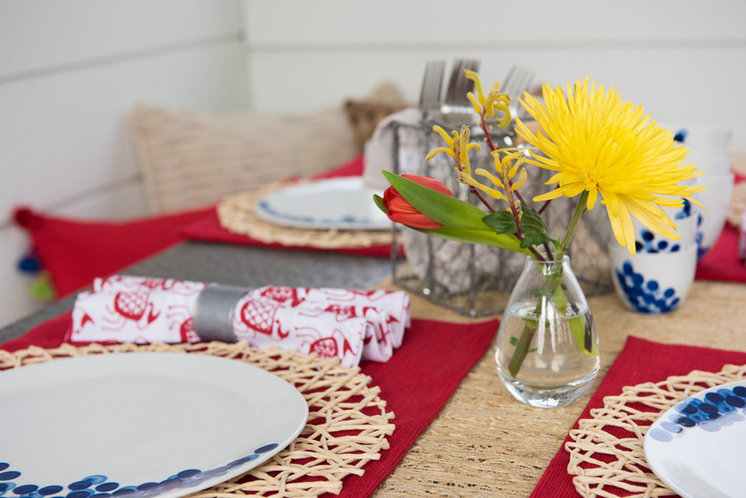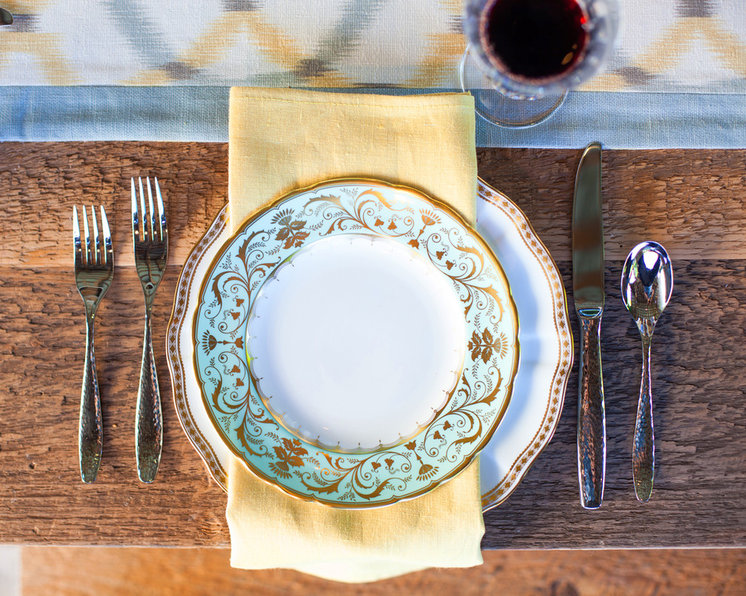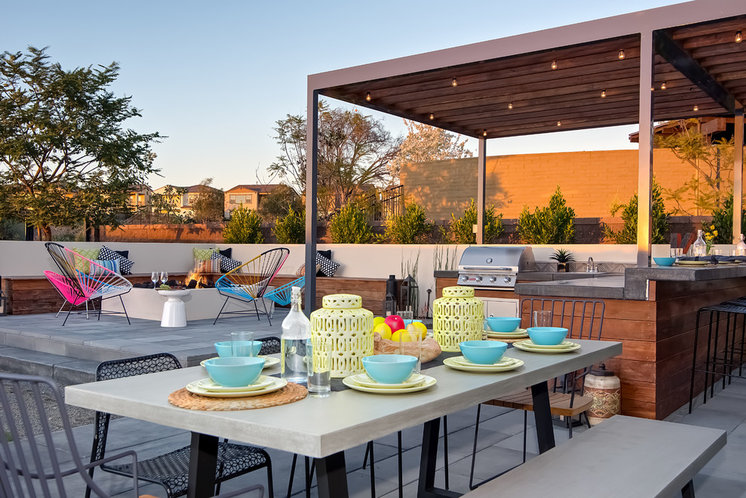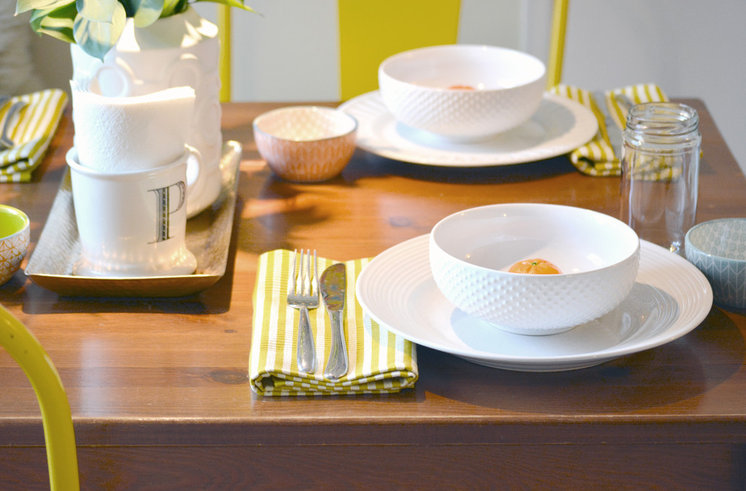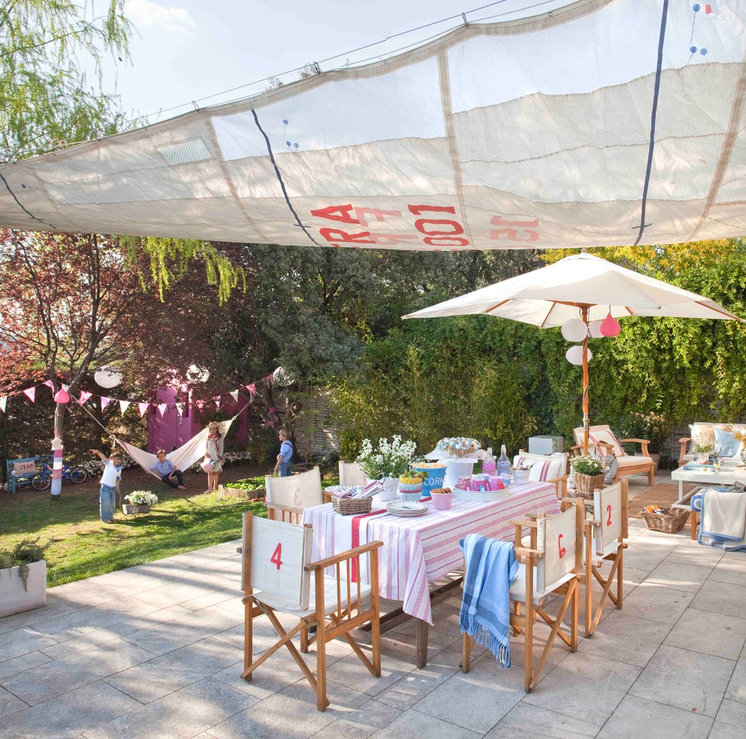So you’ve got the space, you’ve nailed the recipes, your guests are on their way — now set the table!
But how?
As Houzz contributor Rikki Snyder says, “When in doubt, refer to the old-fashioned way.” So we’ve come up with a few easy guidelines, tips and tricks from our pros to help Houzz home cooks and party planners do it right.
Regardless of whether you are using placemats, each place setting should be centered to each seat at the table. There should be about 24 to 30 inches of space between place settings, or about 18 inches between seated guests, to avoid any elbow rubbing.
Silverware. As seen in the photo above, the forks are to be placed on the left side, and the knife (with blade side pointing inward) and spoon on the right. Becky Kubecka, author of the life and style blog This Is Happiness, has a handy trick she learned when she was a kid and continues to use to this day: “‘Left’ is a four-letter word, and so is ‘fork,’ so the left side of my plate is where my fork is placed. ‘Right’ is a five-letter word, and so is ‘knife’ and ‘spoon,’ so they sit on the right side of my plate.”
The movie Titanic taught us well with the line, “Work from the outside in” regarding the crazy amount of silverware we sometimes find in fine-dining restaurants. This rule applies to home dining as well. If you’re serving a salad, the salad fork goes on the outermost left side. If salad is not a starter, the smaller fork can be eliminated or placed on the inside, if needed, for dessert. The same goes for the spoon on the right: If guests will be using it early in the meal, it will go to the right of the knife; if it will be used only for coffee and dessert, place it to the left of the knife.
Think of it this way: It’s a lot easier for guests to grab the utensils they’ll need immediately as well as for you to clear the table as the meal service progresses.
Glassware. Whether you serve water, wine or a cocktail, your glassware of choice should be placed just above the knife on the top-right side of each place setting. Jennifer Grey of Jennifer Grey Interiors, who prefers to host buffets, recommends having an extra set of glassware wherever your drink station is located, in addition to those at the dinner table. “People won’t eat or drink unless they know they can,” she says, so when your guests arrive, those glasses will indicate that the bar is open. When they sit down to dinner, they’ll have a clean glass if needed.
Alright, you’ve got your flatware and glassware sorted out, but what’s the deal with the stacks of plates and bowls? Multiple pieces of dishware aren’t always necessary, but depending on what you’re serving and how, you may need to know a few tips.
This time we’re working from the top down. Summer weather isn’t necessarily soup weather, but on the off chance you are serving soup (gazpacho, anyone?) or an appetizer that would best be enjoyed from a bowl, the bowl should be placed at the top center of your place setting.
This is also a great place to get creative, according to our pros — who suggest using seasonal fruits and florals to add a decorative element to each place setting. In the summer, Kubecka loves a bright yellow lemon on a white dish, and Grey likes to pull roses or lavender straight from her garden. They both agree that the best decorative pieces come from what’s already around, so look to your home and garden for season-specific inspiration.
Underneath the bowl, or in its stead, is the salad plate. If you’re not serving a salad, or the salad is part of the main dish, you can eliminate this layer. Last, if your meal is to be served family or buffet style, like at most informal summer get-togethers, the large bottom plate is your main course plate.
You’ll see different napkin displays in different restaurants, households and photos: in a ring, on the side, folded into abstract origami. So which way is correct?
It’s up to you. If you’re staying simple, a folded napkin can go underneath the forks on the left side or on top of the largest, bottommost plate (in which case, any smaller dishware will be placed on top of the napkin, as in the previous photo). If you’re using a ring, the rolled napkin can be placed either on the left side outside of the forks or in the center of the topmost plate — and the same goes for any artfully folded napkins. However, don’t place a napkin in or on a bowl. Instead, try adding a decorative element like our pros suggest.
We’ve covered all the cut-and-dried rules to setting a table, but here are some extra servings of advice from Houzz professionals.
Snyder tells us that when it comes to tableware, “mixing and matching is really in. Keeping it within the same color scheme creates a pretty palette.”
But when choosing that tableware, Grey says, “even in an informal setting, anything that goes into a guest’s mouth should not be plastic!” This may not be the time to break out your great-grandmother’s fine china, but ditch the plastic party cups and invest in some inexpensive plates, glasses and utensils you’re comfortable sharing with guests. Grey believes in entertaining with all five senses: sight, smell, sound, taste and touch. These last two are affected by the serveware.
Also, even though Grey prefers hosting buffet-style dinner parties, she still creates a place setting, complete with place cards, for each guest at the dinner table. She does this as a courtesy to her guests: They can serve themselves without worrying about forgetting to grab a napkin, juggling their wineglasses or struggling with where to sit amid all the other guests.
Kubecka, on the other hand, favors hosting family-style meals in an intimate setting and advises, “The main thing is to remember to keep things simple, so you can focus on enjoying each other’s company.”
When it comes to table decorations and centerpieces, less is more. Homemade place cards, scented candles or DIY flower arrangements from your garden are all it takes to set the intended mood. Regardless, all our pros agree that it’s best to keep any centerpieces low or remove any major decorations from the dinner table prior to the meal service, so guests can make eye contact, pass plates and avoid any spills.
The most important decorating tip? Kubecka tells us, “Set your table with things you truly love.” If you’re happy and comfortable, your guests will be too.
